During his speaking session, on his recently published book ‘Remembering the Raj’, at Jaipur Literary Festival on Sunday, Congress leader Shashi Tharoor said that including the great Indian Epics such as the Mahabharata and the Ramayana in the curriculum was in fact a very important change that the Education System in India should look into. The inclusion of these epics would make the younger generation of India more aware of the country’s rich literary past as well as help them gain lessons in life depicted through the mythological heroes in the epics.
Speaking about the English curriculum Shashi Tharoor said, “Shakespeare is being taught in schools and colleges in India, but there has not been enough emphasis on teaching Kalidasa.” Tharoor argued that just like the Greek epics ‘Iliad’ and ‘Odyssey’, the great Indian Epics should be included in the curriculum of the schools and colleges.
Tharoor also spoke about his book ‘Remembering the Raj’ and said that while it was important to forgive, it was also essential that we never forget that when the British came here, India was the richest country; but the legacy of the British rules framed to serve the British interests resulted in reducing India to one of the poorest.
Is the Curriculum politicised?
The curriculum in India has always reflected the ruling party’s agenda. The subject matter of history is an intellectual tussle where the left wing and the right wing are in a constant tug of war as to what should be the content of the books. Once the elections are held, the subject matter is according to the party that has won the maximum seats.
A small example of this intellectual tussle can be seen in the following scenario which happened in the period 1998-2005.
- In 1998 during the NDA government, right-wing historian, Meenakshi Jain’s book on medieval India was included in the school syllabus.
- She felt that there was an imbalance in the history taught at that time for while with the emergence of Islamic power in India, there was an encounter between two evolving civilisations, but the NCERT books elevated one side to the detriment of the other.
- However, in 2005, when the UPA came into power, Jain’s book was withdrawn from the curriculum for the new government wanted to “de-saffronise” the text book.
In this intellectual tussle between the left-wing and the right-wing, of the political parties in power and vying for power, the students of India have remained confused and unfortunately are not getting to learn the real and factual rich cultural heritage of India. What they learn seems to be what the politicians in power want them to learn.
Wrong Information
Leave alone politicising of the text books, the NCERT books also have been found to have some bizarre information which reflects a regressive outlook of the autonomous organisation of the Government of India. Glaring mistakes, downright lies and embellishments that are so often found in its textbooks reflect its tied-to-flaws attitude towards shaping the future of the younger generations. Here are a few bizarre things found in the NCERT books in recent times:
- In Chattisgarh, a text book for 15-year-olds in the state stated that the unemployment levels in India have risen because women have started working post-independence.
- In 2012, a national textbook for 11-year-old students stated that people who eat meat “easily cheat, tell lies, forget promises, are dishonest and tell bad words, steal, fight and turn to violence and commit sex crimes”.
- In a textbook, in 2006, housewives were compared to donkeys.
- In a complete distortion of history, a textbook in Gujarat stated that Japan had launched a Nuclear attack on the United States of America during the World War II. The same textbook also got the assassination date of Mahatma Gandhi wrong.
- A textbook in Maharashtra taught the students that “Sewage” Canal is one of the most important shipping lanes of the world, only that they got the spelling of “Suez” wrong!!
The Indian Education System needs to seriously think about revamping the books, not as per the political party in power, but while keeping the children, the future of India, in mind. The books should encourage analytical thinking rather that learning by rote. And here comes the importance of the great India epics, written by some of the greatest saints, apolitical as well as thought provoking.
Should Epics be included in the Curriculum?
While many may feel that these epics are only about God, His teaching and activities, the reality is that these great epics are made up of collective wisdoms of many centuries, which act as a teaching tool for ‘dharma‘ and other Hindu concepts helping the students learn the moral values of life.
Until the beginning of the modern era these epics were not only the main sources of entertainment in the form of storytelling as well as theatre, but also enlightened the masses. In fact, even works by Homer, Shakespeare and other Greek and Roman writers’ works pale in comparison to these two great epics.
The structural complexity, recursive narratives, analysis of the human conduct, and complex characterisation of these two epics set them apart from the other great compositions from across the world.
Kalidasa’s plays and poetry, based on the ‘Puranas‘ can give competition to the Greek epics ‘Iliad’ and its sequel ‘The Odyssey’ any day. Kalidasa’s work has evoked inspiration among the artistic circles of Europe during the late 19th century and early 20th century, as evidenced by Camille Claudel’s sculpture ‘Shakuntala‘.
India being a secular country is also home to the works of Gurunanak Dev Ji and the other Sikh Gurus in the form of Gurbani as well as the Zoroastrian holy book, called the ‘Avesta‘, which is closely related to Vedic Sanskrit.
Inclusion of these great works of literature will help the younger generation connect with the rich cultural heritage of India without planting in them pre-conceived notions.
Sanskrit as a part of the Curriculum
While Sanskrit is indeed a part of the curriculum from Class VI until VIII, the most ancient language in the world is being taught only as formality, where the children learn by rote just for the sake of scoring marks and not as a language that their forefathers spoke in.
While in India you do not find many takers for this rich language, in Britain schools have Sanskrit in their curriculum for students aged between four and 18. After completing their levels here, students can go for courses at prestigious universities like Oxford, Cambridge and Edinburgh.
Maybe it is time India recognised the importance of this language in which the Vedas and the Upanishads have been written and included it as a language from Class I till at least Class X.
Time for a Change
If India wants to become a good, well-learned society in the future, then its education system needs to seriously think about changing the syllabus and include the great epics as well as the language Sanskrit in its curriculum. Education today is so much more about presenting to students situations where they learn to analyse and arrive at the right conclusion.
The rich Indian literature from the past will help the children in being more analytical. It is time to bring back the rich cultural heritage of India by including them in the syllabus.
Read More…





